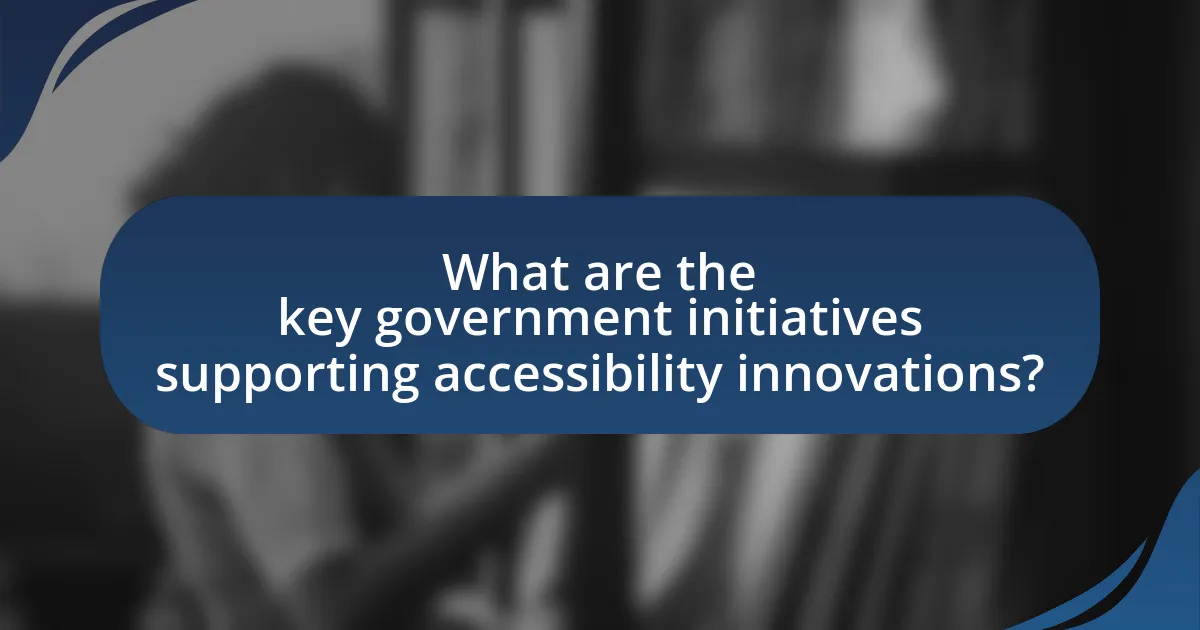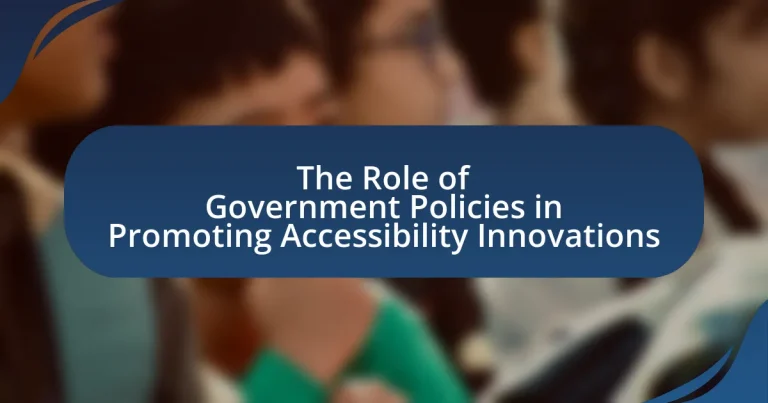The article examines the critical role of government policies in promoting accessibility innovations, highlighting how regulations and funding initiatives foster the development of inclusive technologies. It discusses the impact of legislation such as the Americans with Disabilities Act (ADA) on accessibility standards and the importance of government grants and tax incentives in stimulating research and development. The article also explores effective government initiatives, the social and economic implications of improved accessibility, and the collaboration between government and private sectors to enhance accessibility solutions. Additionally, it addresses the challenges businesses face in compliance and the metrics used to measure the success of accessibility initiatives.

What is the role of government policies in promoting accessibility innovations?
Government policies play a crucial role in promoting accessibility innovations by establishing regulations and funding initiatives that encourage the development of inclusive technologies. These policies often mandate compliance with accessibility standards, such as the Americans with Disabilities Act (ADA) in the United States, which requires public spaces and digital platforms to be accessible to individuals with disabilities. Additionally, government grants and tax incentives can stimulate research and development in accessibility solutions, as seen in programs like the National Institute on Disability, Independent Living, and Rehabilitation Research (NIDILRR), which funds projects aimed at enhancing accessibility. By creating a supportive legal and financial framework, government policies drive innovation and ensure that accessibility becomes a priority in technological advancements.
How do government policies influence accessibility innovations?
Government policies significantly influence accessibility innovations by establishing regulations and funding that promote inclusive design and technology. For instance, the Americans with Disabilities Act (ADA) mandates that public spaces and services be accessible, driving innovation in assistive technologies and design practices. Additionally, government grants and incentives for research and development in accessibility can lead to breakthroughs in products and services that cater to individuals with disabilities. These policies create a framework that encourages private sector investment in accessibility solutions, ultimately enhancing the quality of life for people with disabilities.
What types of government policies are most effective in promoting accessibility?
Government policies that are most effective in promoting accessibility include legislation mandating universal design standards, funding for accessibility initiatives, and incentives for businesses to adopt inclusive practices. Universal design standards, such as the Americans with Disabilities Act (ADA) in the United States, require public spaces to be accessible to individuals with disabilities, thereby ensuring compliance and promoting inclusivity. Funding initiatives, like grants for retrofitting buildings or developing assistive technologies, directly support accessibility improvements. Additionally, tax incentives for businesses that implement accessibility features encourage private sector participation in creating inclusive environments. These policies collectively enhance accessibility and foster a culture of inclusion across various sectors.
How do these policies impact the development of new technologies?
Government policies significantly influence the development of new technologies by providing funding, setting regulations, and creating incentives for innovation. For instance, policies that allocate grants for research and development can accelerate technological advancements, as seen in the U.S. National Institutes of Health’s funding for biomedical innovations, which has led to breakthroughs in medical technology. Additionally, regulations that mandate accessibility standards, such as the Americans with Disabilities Act, compel companies to innovate solutions that meet these requirements, fostering the creation of assistive technologies. Thus, government policies serve as a catalyst for technological growth by directing resources and establishing frameworks that encourage innovation.
Why is accessibility important in today’s society?
Accessibility is important in today’s society because it ensures equal opportunities for all individuals, regardless of their abilities or disabilities. This inclusivity fosters social equity, allowing people with disabilities to participate fully in education, employment, and community life. According to the World Health Organization, over 1 billion people, or about 15% of the global population, experience some form of disability, highlighting the necessity for accessible environments and services. Furthermore, studies show that businesses that prioritize accessibility can tap into a larger customer base, enhancing economic growth. Therefore, accessibility is not just a moral imperative but also a practical necessity for societal advancement.
What are the social implications of improved accessibility?
Improved accessibility leads to enhanced social inclusion and equality for individuals with disabilities. When environments, services, and technologies are made accessible, people with disabilities can participate fully in society, including education, employment, and community activities. According to the World Health Organization, over 1 billion people experience some form of disability, highlighting the need for inclusive policies. Improved accessibility not only benefits individuals but also fosters a more diverse and equitable society, as it allows for greater participation in the workforce and reduces social isolation. Studies show that inclusive practices can lead to economic benefits, with companies that prioritize accessibility seeing increased productivity and employee satisfaction.
How does accessibility contribute to economic growth?
Accessibility contributes to economic growth by enabling a larger segment of the population to participate in the workforce and consume goods and services. When individuals with disabilities or those facing barriers can access employment opportunities, productivity increases, leading to higher overall economic output. For instance, a study by the World Bank found that removing barriers for people with disabilities could increase GDP by up to 7% in some countries. Furthermore, accessible environments stimulate innovation and competition among businesses, as they adapt to meet diverse consumer needs, ultimately driving economic development.

What are the key government initiatives supporting accessibility innovations?
Key government initiatives supporting accessibility innovations include the Americans with Disabilities Act (ADA), which mandates accessibility in public spaces and services, and the Assistive Technology Act, which provides funding for assistive technology programs. The ADA, enacted in 1990, has significantly influenced the design of accessible environments, while the Assistive Technology Act, reauthorized in 2015, supports state programs that enhance access to technology for individuals with disabilities. Additionally, the U.S. Access Board develops accessibility guidelines and standards, ensuring compliance across various sectors. These initiatives collectively foster an inclusive society by promoting innovations that enhance accessibility for all individuals.
How do funding programs support accessibility innovations?
Funding programs support accessibility innovations by providing financial resources that enable the development and implementation of technologies designed to enhance accessibility for individuals with disabilities. These programs often allocate grants, subsidies, or tax incentives specifically aimed at organizations and startups focused on creating accessible solutions. For instance, the National Institute on Disability, Independent Living, and Rehabilitation Research (NIDILRR) in the United States funds projects that explore innovative assistive technologies, demonstrating a commitment to improving accessibility. Such funding not only fosters research and development but also encourages collaboration among stakeholders, ensuring that innovations are practical and meet the needs of the disabled community.
What are the criteria for government funding in accessibility projects?
Government funding for accessibility projects typically requires that the projects demonstrate a clear benefit to individuals with disabilities, align with national or local accessibility standards, and include a detailed budget and timeline. Additionally, projects must often show community support and collaboration with relevant stakeholders, such as disability advocacy groups. These criteria ensure that funded projects effectively address accessibility needs and promote inclusivity.
How successful have these funding programs been in fostering innovation?
Funding programs have been highly successful in fostering innovation, particularly in the realm of accessibility. For instance, the National Institutes of Health (NIH) reported that their Small Business Innovation Research (SBIR) program has led to the development of over 1,000 new products and services aimed at improving accessibility for individuals with disabilities. Additionally, a study by the National Science Foundation (NSF) indicated that government funding has catalyzed a 30% increase in patents related to assistive technologies over the past decade. These statistics demonstrate that targeted funding initiatives effectively stimulate innovation and enhance accessibility solutions.
What regulations exist to ensure accessibility in public spaces?
The Americans with Disabilities Act (ADA) is a key regulation that ensures accessibility in public spaces in the United States. Enacted in 1990, the ADA mandates that public facilities, including buildings, transportation, and services, must be accessible to individuals with disabilities. This includes requirements for ramps, elevators, accessible restrooms, and clear signage. The ADA has been instrumental in promoting equal access and has led to significant improvements in the physical environment for people with disabilities, as evidenced by the increased number of accessible public spaces since its implementation.
How do these regulations vary across different regions?
Regulations promoting accessibility innovations vary significantly across different regions due to local legal frameworks, cultural attitudes, and economic conditions. For instance, the United States enforces the Americans with Disabilities Act (ADA), which mandates accessibility in public spaces and employment, while the European Union has the European Accessibility Act, which focuses on making products and services accessible. In contrast, countries in developing regions may lack comprehensive legislation, resulting in inconsistent enforcement and limited resources for accessibility initiatives. This disparity highlights how regional governance and societal values shape the effectiveness and scope of accessibility regulations.
What challenges do businesses face in complying with accessibility regulations?
Businesses face several challenges in complying with accessibility regulations, primarily due to the complexity of the regulations and the lack of resources. The intricate nature of laws, such as the Americans with Disabilities Act (ADA) and the Web Content Accessibility Guidelines (WCAG), often leads to confusion regarding specific requirements. Additionally, many businesses, especially small and medium-sized enterprises, struggle with limited budgets and expertise to implement necessary changes. According to a 2020 report by the National Federation of the Blind, 70% of businesses cited financial constraints as a significant barrier to achieving compliance. Furthermore, the rapid pace of technological advancements can make it difficult for businesses to keep up with evolving accessibility standards, resulting in unintentional non-compliance.

How do government policies collaborate with private sectors to enhance accessibility?
Government policies collaborate with private sectors to enhance accessibility through regulatory frameworks, funding initiatives, and public-private partnerships. These collaborations often involve the establishment of standards and guidelines that private companies must follow to ensure their products and services are accessible to all individuals, including those with disabilities. For example, the Americans with Disabilities Act (ADA) mandates accessibility in public spaces, prompting businesses to adapt their facilities and services accordingly. Additionally, government grants and tax incentives encourage private sector investment in accessibility innovations, leading to the development of assistive technologies and inclusive design practices. This synergy not only improves accessibility but also fosters economic growth by expanding market reach for businesses that prioritize inclusivity.
What partnerships exist between government and private organizations?
Partnerships between government and private organizations include public-private partnerships (PPPs), where both sectors collaborate on projects such as infrastructure development, healthcare, and technology innovation. For instance, the U.S. government has engaged with private firms like Google and Microsoft to enhance accessibility in technology through initiatives like the Accessibility Innovation Challenge, which aims to develop solutions for individuals with disabilities. These collaborations leverage resources and expertise from both sectors, resulting in improved services and innovations that benefit the public.
How do these partnerships drive innovation in accessibility technologies?
Partnerships drive innovation in accessibility technologies by fostering collaboration between government entities, private companies, and non-profit organizations, leading to the development of more effective solutions. These collaborations leverage diverse expertise and resources, enabling the creation of technologies that address specific accessibility challenges faced by individuals with disabilities. For instance, initiatives like the Partnership on Employment & Accessible Technology (PEAT) have resulted in the development of tools that enhance workplace accessibility, demonstrating the tangible impact of such partnerships on innovation.
What role do non-profit organizations play in this collaboration?
Non-profit organizations play a crucial role in collaboration by advocating for accessibility innovations and bridging gaps between government policies and community needs. They often serve as intermediaries, facilitating communication and partnerships among stakeholders, including government entities, private sectors, and individuals with disabilities. For instance, non-profits like the National Federation of the Blind actively engage in policy discussions, providing insights and recommendations that shape legislation aimed at enhancing accessibility. Their involvement ensures that the voices of marginalized communities are heard, leading to more effective and inclusive policy outcomes.
What are the outcomes of successful government policies on accessibility?
Successful government policies on accessibility lead to increased participation of individuals with disabilities in society. These policies often result in improved infrastructure, such as ramps and accessible public transportation, which facilitate mobility. For instance, the implementation of the Americans with Disabilities Act (ADA) in the United States has significantly enhanced access to public spaces, leading to a reported 25% increase in employment rates among individuals with disabilities since its enactment. Additionally, successful policies promote awareness and education, fostering a more inclusive environment that encourages businesses to adopt accessibility standards, ultimately benefiting the economy and society as a whole.
How do these outcomes affect individuals with disabilities?
Outcomes from government policies promoting accessibility innovations significantly enhance the quality of life for individuals with disabilities. These policies often lead to improved access to public spaces, transportation, and technology, which directly reduces barriers faced by this population. For instance, the implementation of the Americans with Disabilities Act (ADA) in the United States has resulted in increased physical accessibility in buildings and public transport, allowing individuals with disabilities to participate more fully in society. Additionally, innovations such as assistive technologies funded by government initiatives have been shown to improve communication and mobility for individuals with disabilities, further integrating them into various aspects of daily life.
What metrics are used to measure the success of accessibility initiatives?
Metrics used to measure the success of accessibility initiatives include user satisfaction surveys, compliance with accessibility standards (such as WCAG), and the rate of reported accessibility issues. User satisfaction surveys provide direct feedback from individuals with disabilities regarding their experiences, while compliance metrics assess whether initiatives meet established guidelines, indicating a baseline level of accessibility. The rate of reported accessibility issues reflects the effectiveness of initiatives in addressing barriers, with a decrease in reported issues suggesting improved accessibility. These metrics collectively offer a comprehensive view of the impact and effectiveness of accessibility initiatives.
What best practices can governments adopt to further promote accessibility innovations?
Governments can adopt several best practices to promote accessibility innovations, including implementing inclusive policy frameworks, providing funding for research and development, and fostering public-private partnerships. Inclusive policy frameworks ensure that accessibility is integrated into all levels of government planning and decision-making, as seen in the United Nations Convention on the Rights of Persons with Disabilities, which emphasizes the importance of accessibility in various sectors. Funding for research and development can stimulate innovation; for instance, the U.S. government allocated over $1 billion in 2021 for technology development aimed at improving accessibility for individuals with disabilities. Public-private partnerships can leverage resources and expertise from both sectors, exemplified by initiatives like the Partnership on Employment & Accessible Technology, which brings together businesses and government to enhance workplace accessibility. These practices collectively create an environment conducive to accessibility innovations.




